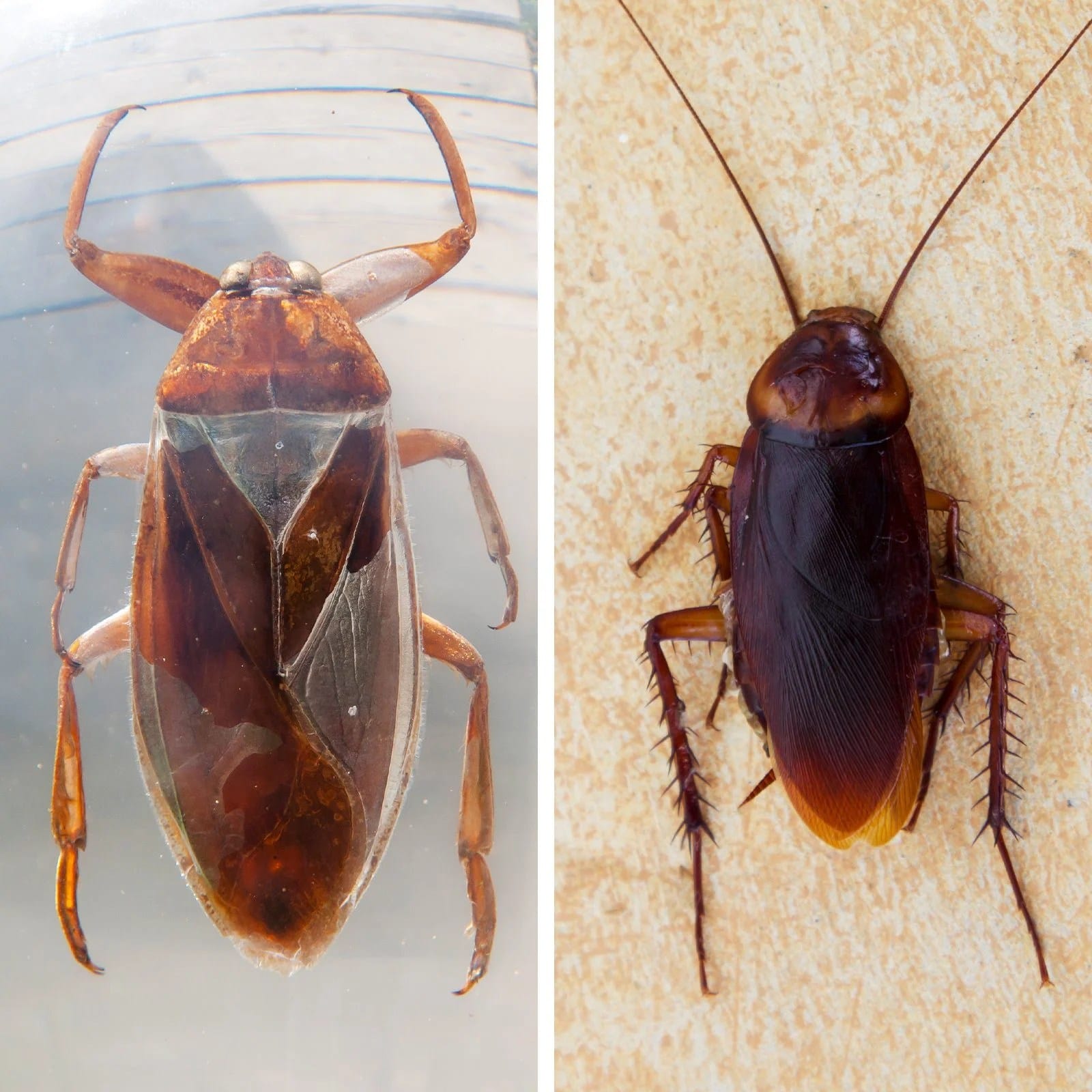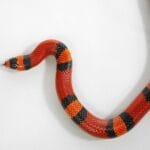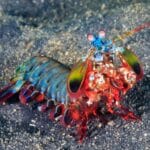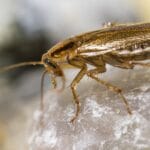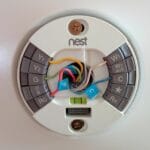What’s the Deal with “Water Bugs”?
Ever squirmed at the sight of a creepy crawler in your bathroom and called it a “water bug”? You’re not alone! This common nickname often leads to confusion, blurring the lines between roaches that love damp spaces and true water bugs that live in ponds and lakes. Let’s clear up the confusion, dive into some fascinating facts, and equip you with the knowledge to handle these unwanted guests. For an in-depth look at other fascinating marine life, check out our articles on the pistol shrimp vs mantis shrimp and the captivating Pueblan milk snake.
Debunking the “Water Bug” Myth
The term “water bug” isn’t a scientific classification. It’s more of a colloquialism, often used to describe certain types of cockroaches, particularly those found in damp environments like basements and drains. This often leads to the misidentification of the American, Oriental, or Smokybrown cockroach. True water bugs, however, belong to the Hemiptera order, spending their lives in or near bodies of water.
Roach or True Water Bug: Spotting the Difference
So, how can you tell them apart? Their physical traits offer some clues. Cockroaches, including those mistakenly called “water bugs,” are typically flat and oval-shaped, with long antennae and six legs. Some roaches can even fly! True water bugs, on the other hand, display a variety of body shapes adapted for aquatic life. Some possess sharp mouthparts for hunting, a feature you won’t find on a cockroach. Here’s a quick comparison:
| Feature | Cockroach (Often Called “Water Bug”) | True Water Bug |
|---|---|---|
| Habitat | Damp areas in homes, sewers, outdoors | Ponds, streams, lakes |
| Size | Varies, from tiny to over 2 inches | Varies, some can be quite large |
| Diet | Omnivorous (scavengers) | Predatory (eat other insects) |
| Appearance | Flat, oval body, long antennae | Various shapes, adapted for water |
| Behavior | Nocturnal, fast, often found in groups | Varies depending on the species |
Why Correct Identification Matters
Knowing the difference is critical for effective pest control. Using cockroach bait on a true water bug won’t solve your problem. Misidentification leads to wasted time and effort, allowing the infestation to persist. Accurate identification ensures you choose the right solution.
Choosing the Right Approach
If you’re dealing with roaches mistakenly called “water bugs,” focus on sanitation, sealing entry points, reducing moisture, and using baits or insecticides. If you find a true water bug indoors, it’s likely wandered in by accident. Minimize standing water around your property and reduce outdoor lighting that might attract them.
Know Your Roach: A Closer Look at Common Culprits
The “water bug” misnomer often applies to specific cockroach species:
The Oriental Cockroach (Blatta orientalis)
Often misidentified as a water bug due to its dark brown/black color, large size, and preference for damp areas like basements and drains. Though it thrives in moisture, it’s not aquatic.
The American Cockroach (Periplaneta americana)
Another common “water bug” suspect. This large, reddish-brown roach with a yellow band behind its head often inhabits sewers and drains. Its size might contribute to the misconception, as people sometimes associate larger insects with aquatic life.
The German cockroach (Blattella germanica):
While smaller and lighter than the Oriental cockroach, its prevalence in kitchens and bathrooms, areas often associated with water, sometimes results in the “water bug” label.
True Water Bugs (Order Hemiptera – e.g., Giant Water Bugs)
Unlike cockroaches, true water bugs are adapted for life in aquatic environments. Some, like the giant water bug, can inflict painful bites. Their morphology is distinct from cockroaches, with features tailored for swimming and predation.
Why it Matters: Targeting Effective Pest Control
Accurate identification is paramount for effective pest control. Mistaking a roach for a water bug (or vice versa) leads to using the wrong methods, resulting in frustration and persistent infestations. Knowing the specific pest allows you to target its vulnerabilities, whether through baits, traps, or professional extermination.
Should I Panic Over One Roach?
Spotting a single cockroach isn’t necessarily a sign of a massive infestation, but it does warrant investigation. Think of it as a scout, potentially signaling a hidden nest. While it’s not time to panic, it is time to act. Ignoring that lone ranger could lead to a full-blown infestation.
One Roach, Many Hiding?
One cockroach likely suggests others lurking nearby. Cockroaches are adept at hiding, favoring dark, secluded spaces. So, if you see one in the open, there are probably more concealed within walls, under appliances, or in other hard-to-reach areas.
Subtle Signs of an Infestation
Even without seeing a live cockroach, other clues can reveal their presence:
- Droppings: Small, dark, and resembling coffee grounds or black pepper.
- Shed Skin: Translucent exoskeletons, often found near their hiding places.
- Egg Cases (oothecae): Small, brown capsules containing multiple eggs.
- Musty Odor: A persistent, oily or sweet smell.
Taking Action: Prevention and Control
If you see a cockroach:
- Inspect: Check under sinks, behind appliances, in pantries – anywhere dark, damp, and undisturbed.
- Clean: Eliminate food and water sources. Regular cleaning and proper food storage are essential.
- Seal: Caulk cracks and crevices, especially around pipes and baseboards.
- Bait and Trap: Strategically place baits and traps.
- Call a Pro: If the problem persists, consult a pest control professional.
Why “Water Bugs” in New York?
The term “water bug” for cockroaches is a New York City peculiarity. It’s not a distinct species; it’s simply another name for certain types of cockroaches, especially the American and Oriental cockroaches.
A Damp History: Origins of the Nickname
The nickname likely stems from these roaches’ preference for damp, shadowy environments like basements, sewers, and areas around leaky pipes. Their affinity for moisture likely led to the erroneous assumption that they live in water.
A Linguistic Quirk: Why NYC?
While pest control professionals use the term “cockroach,” “water bug” persists in NYC vernacular. It may be a euphemism, a way to avoid the negative connotations of “roach,” or simply a deeply ingrained local slang.
True Water Bugs vs. NYC “Water Bugs”
True water bugs, like the giant water bug, are entirely different insects adapted for aquatic life. They’re not the same as the “water bugs” scurrying around NYC kitchens.
| Feature | “Waterbug” (Cockroach) | True Water Bug |
|---|---|---|
| Habitat | Damp areas indoors | Ponds, lakes, rivers |
| Appearance | Flat, oval, long antennae | Varied, adapted for swimming |
| Relation to Water | Prefers dampness | Lives in water |
| Bites? | No | Some species do (e.g., giant water bugs) |
So, the next time you hear “water bug,” remember the fascinating story behind this NYC nickname – and the importance of knowing the real difference between a cockroach and a true water bug.
- Sebewaing, MI: Where Small-Town Charm Meets Saginaw Bay’s Bounty - November 23, 2024
- Accessing Carteret County Register of Deeds Records: A Guide for Genealogy and Real Estate Research - November 23, 2024
- Norwayne Local Schools: A Comprehensive Guide for Parents and Students (2023-24) - November 23, 2024
